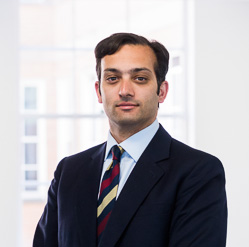Fri, 12 Jun 2020
The recent appeal decision in Paul v The Royal Wolverhampton NHS Trust [2020] EWHC 1415 (QB) will come as welcome news to claimants and their representatives in secondary victims claims arising out of clinical acts or omissions. In overturning Master Cook’s previous determination, Mr Justice Chamberlain has provided greater clarity in the approach the courts should take in cases of this nature.
The case stems from the tragic death of Mr Parminder Singh Paul and is brought by his wife on her own behalf and on the behalf of their two children, Saffron and Mya. On 9 November 2012, Mr Paul was admitted to New Cross Hospital, with symptoms of chest pain radiating to his jaw. Following various investigations, he was discharged after three days. Some 14 months later, on 26 January 2014, Mr Paul was out shopping with his daughters, aged 9 and 12 at the time, when he suffered a fatal myocardial infarction. Both children witnessed their father’s collapse and the subsequent distressing scenes. The event was sufficiently shocking to them to cause them psychiatric harm.
Mr Paul’s cause of death was attributed to ischaemic heart disease and occlusive coronary atherosclerosis. The Claimants brought a claim against the Defendant Trust, pleading that it was negligent to have failed to diagnose the pathologies whilst he was an inpatient in November 2012. The Claimants allege that, had a coronary angiogram been performed, the severity of Mr Paul’s coronary atherosclerosis would have been revealed and treated. It flows, the Claimants said, that had coronary revascularisation treatment been performed, Mr Paul would not have suffered his fatal coronary event 14 months later. Evidently, his daughters would not then have suffered psychiatric injury.
In response, the Defendant accepted that it owed Mr Paul’s widow a duty of care. However, it did not accept that its duty of care extended to his children. An application was made on behalf of the Defendant to strike out Saffron and Mya’s statements of case. The application was heard before Master Cook who concluded that:
“[40] To focus simply on the death of Mr Paul as being the first point at which the consequence of the defendant’s negligence became apparent is not an approach which is supported by the authorities. To do so overlooks entirely that there must be an approximate connection between the initial negligence and the shocking event. It is this proximity in space and time that allowed Lord Oliver to impose a duty of care in Alcock and was described by Lord Dyson MR in Taylor v A Novo as “a necessary, but not sufficient, condition of legal proximity”. It is this proximity which has been found to exist in all successful secondary victim claims including Walters and it is the lack of such proximity which explains why the claims in cases such as Taylor v Somerset Health Authority and Taylor v A Novo failed.
Master Cook held, applying this logic, that a myocardial infarction that occurred 14 months after the alleged negligent act could not be said to be sufficiently proximate. For this reason, he struck out the children’s psychiatric injury cases as having no reasonable prospects of success.
Permission to appeal Master Cook’s decision was granted by Mr Justice Stewart in January 2020.
Mr Justice Chamberlain commenced his judgment with a critique of the law on secondary victim claims, which he described, by using the words of Lord Steyn in White v Chief Constable of South Yorkshire Police, as “a patchwork quilt of distinctions which are difficult to justify”. To date there has been the lack of a coherent principle underlying the law governing claims of this nature. There has been reluctance to move towards the two logically coherent positions; namely allowing secondary victim claims for psychiatric injury generally or disallowing such injuries generally. Understandably there have been public policy concerns not to allow too many observers in bringing claims for compensation in circumstances akin to this. This resulted in the solution of “control mechanisms” as set out in Alcock v Chief Constable of South Yorkshire Police [1992] AC 310.
In his lengthy judgment Mr Justice Chamberlain highlighted that the key question in this case was whether Mr Paul’s collapse was capable of establishing a “relevant event”. He set out at paragraphs 63-66 of his judgment the three possible reasons that could be advanced for this not constituting such an event. In summary these were as follows:
- Firstly, the “event” has to be synchronous, or approximately synchronous, with the act of negligence which gives rise to it. This argument was not raised by the Respondent. The Learned Judge noted that there was nothing in the authorities considering the control mechanisms to suggest that a claim for psychiatric injury would be affected by the date of the negligence;
- Secondly, that liability depends on there being a negligent act, rather than an omission. Again, this line of argument, not advanced by counsel for the Respondent (the Defendant at first instance) in this case, did not hold up to logical reasoning. There was no good reason to treat negligent acts differently to negligent omissions. This was supported by the cases of North Glamorgan NHS Trust v Walters [2002] EWCA Civ 1792 and White v Lidl UK [2005] EWHC 871 (QB);
- Thirdly, that the Claimants were absent from the “scene of the tort”. This was the approach adopted by the Respondent in this case. Whilst in accident cases the breach of duty and damage caused will be synchronous in time and place, and therefore the “scene of the tort” is one and the same as the scene of the negligence, when the negligence and damage are separated by time and space, such as in clinical negligence cases, the “scene of the tort” can only logically mean the scene at which the tort was actionable or complete. Taking the Claimants’ case at its highest, as he was required to do in the context of a strike out application, the Learned Judge found that the index tort became complete at the time of Mr Paul’s collapse.
Whilst the Respondent raised a number of further arguments as to why the circumstances of this case did not give rise to liability, these were, in turn, rejected by the Learned Judge. In drawing his analysis he stated:
“[75] On this analysis, I would hold that the Master was wrong to conclude that these claims are bound to fail on the facts pleaded. Here, unlike in Taylor v A. Novo, there was on the facts pleaded only one event: Mr Paul’s collapse from a heart attack on 26 January 2014. On the facts pleaded, it was a sudden event, external to the secondary victims, and it led immediately or very rapidly to Mr Paul’s death. The event would have been horrifying to any close family member who witnessed it, and especially so to children of 12 and 9. The fact that the event occurred 14 ½ months after the negligent omission which caused it does not, in and of itself, preclude liability. Nor does the fact that it was not an “accident” in the ordinary sense of the word, but rather an event internal to the primary victim. In a case where such an event is the first occasion on which damage is caused, and therefore the first occasion on which it can be said that the cause of action is complete, Taylor v A. Novo does not preclude liability. As I have explained, for the purposes of this strike-out application, I must assume that the present is such a case.”
Although noting that the analysis thus far was sufficient to overturn Master Cook’s previous decision, Mr Justice Chamberlain went on to consider the scenario in which actionable damage had occurred prior to Mr Paul’s collapse. In doing so he observed that the principles within Taylor v A. Novo (UK) Ltd [2013] EWCA Civ 194 could be drawn across to the index matter.
The case of Taylor v A. Novo would prevent liability attaching to the Respondent if there was an “event” prior to the collapse on 26 January 2014: then the pavement collapse would be a “consequence of the event” rather than “the event” itself. On the pleaded facts, Mr Justice Chamberlain found that there was nothing in the index case that could be labelled as an “event” so as to prevent liability attaching to the collapse in 2014.
The Learned Judge further considered where the “stopping point” may fall, so as to demarcate the end of an actionable event leading to liability for a secondary victim. He recounted the words of Mr Justice Swift in Shorter v Surrey and Sussex Healthcare NHS Trust [2015] EWHC 614 (QB), and concluded that the end point for such liability would be when the damage to the primary victim becomes “evident”. He highlighted that it would be nonsensical for liability solely to depend on whether there had been prior actionable damage that had not been known to either the primary or secondary victim.
The court therefore concluded that, on the facts of this case, the ratio in Taylor v A. Novo did not prevent liability attaching in the index matter.
There is a theme within the Court’s judgment that it viewed some of the Respondent’s submissions as unnecessarily attempting to place hurdles in the way of the path to proving liability in cases involving secondary victims in a clinical negligence setting. It was the Learned Judge’s view that the control mechanisms in place, and the requirements discussed above, were sufficiently stringent such that there would be no danger of the floodgates being opened, as demonstrated by the difficulties faced by other claimants in the reported decisions that Chamberlain J referred to. To implement any more stringent requirements was ultimately a job for Parliament, or more senior courts.
It remains to be seen whether Chamberlain J’s determination will be appealed but, until then, claimants and their legal representatives will be encouraged by this appellate decision. It provides greater clarity for parties pursuing secondary victim claims for pure psychiatric harm arising out of clinical acts or omissions, in circumstances where there is a break in time between the negligence and the horrifying “event”.
Dr Neil Shastri-Hurst and Richard Grimshaw are members of the Personal Injury and Clinical Negligence Groups and represent both claimants and defendants in a range of personal injury and clinical negligence cases.




